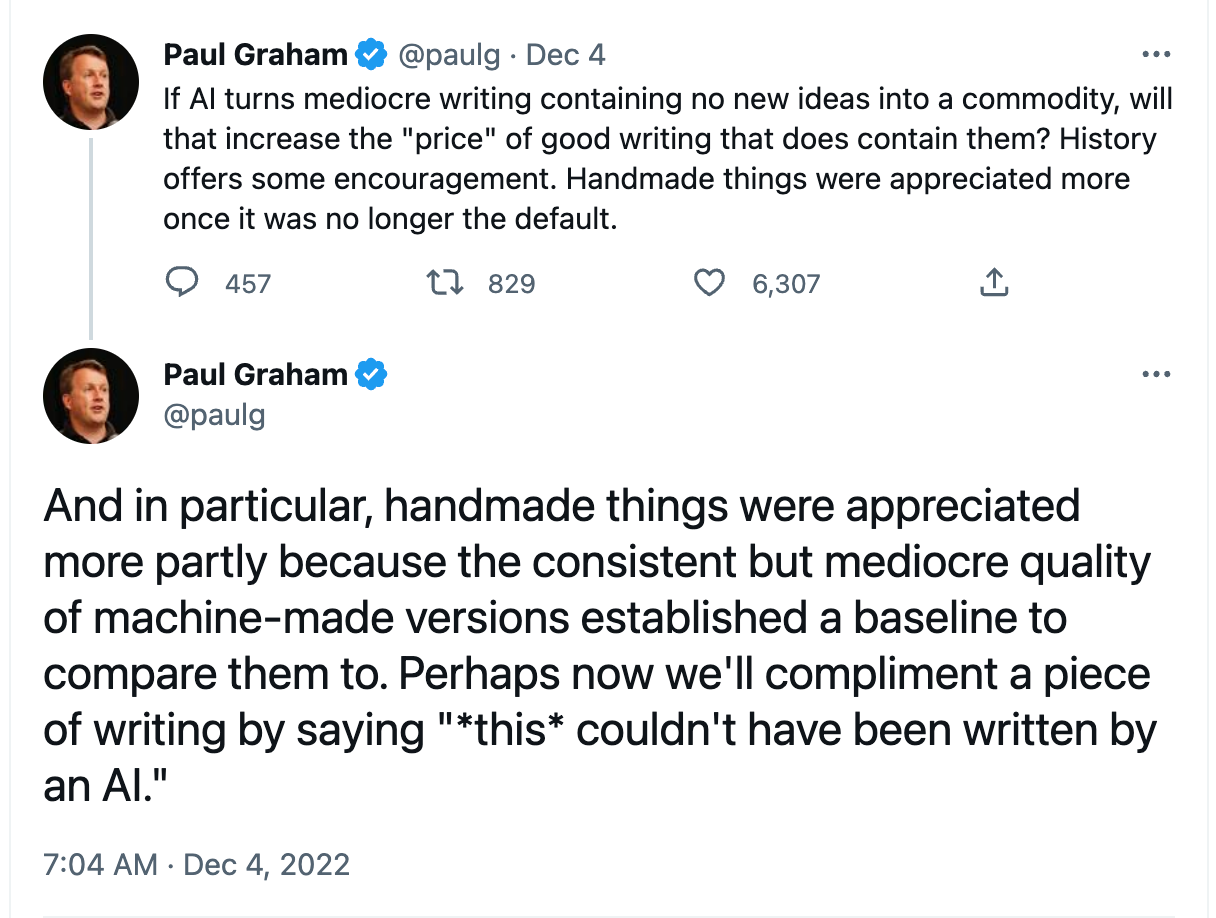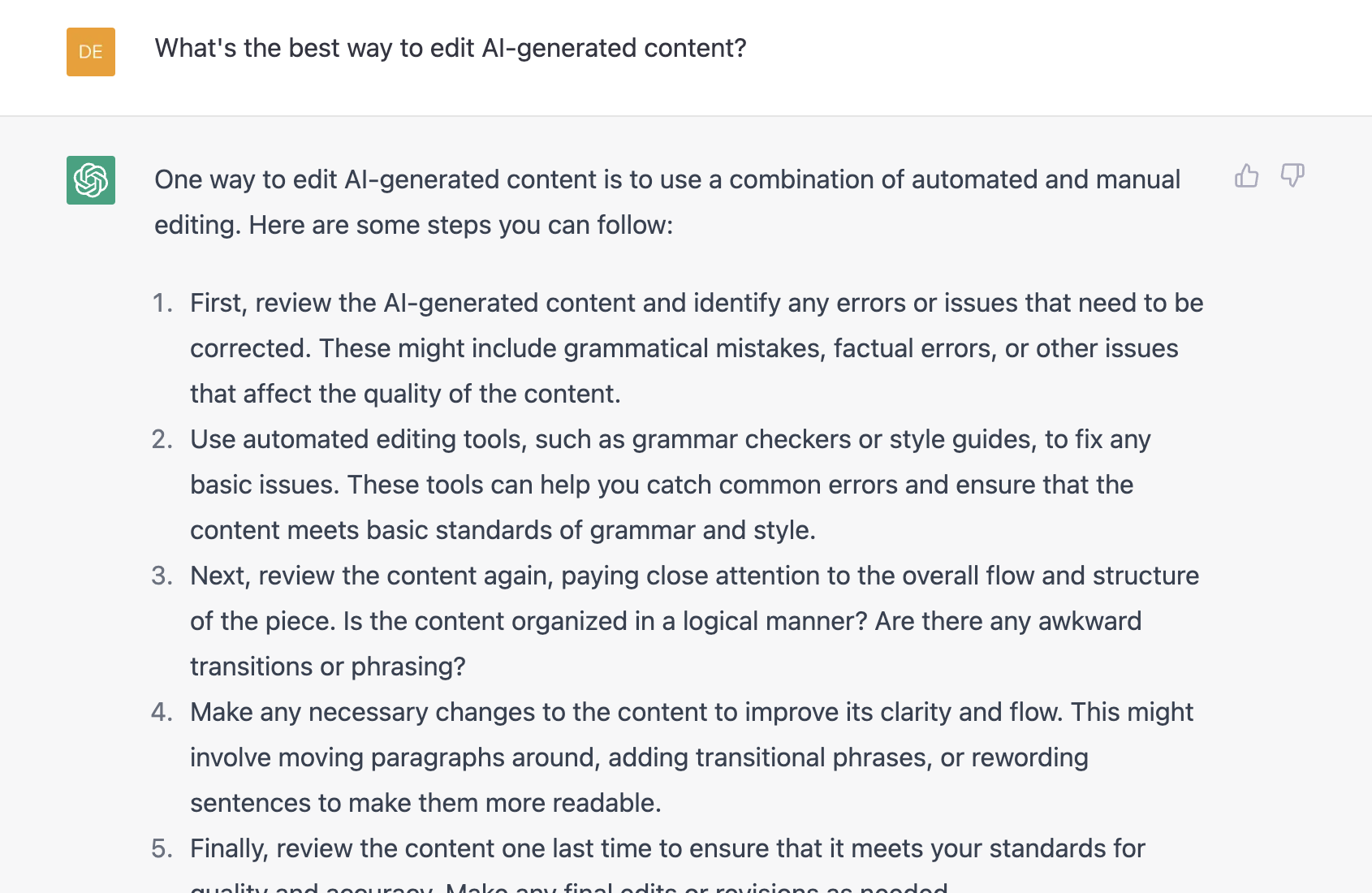This essay originally was published on January 5, 2023, with the email subject line "CT No.149: How to edit AI-generated content."
Disclaimer: I have had a friendly relationship with the team from Writer since 2020, primarily because they’ve supported and read The Content Technologist, and because they have an awesome online style guide builder that recently evolved to include an AI-generated writing tool. Last year I became a partner with Writer because I use their tool in my consulting work and recommend it to clients.
Some traditional news publications would consider my affiliation with Writer to be a conflict of interest. Good thing I’m not writing for them and make my own rules! As part of The Content Technologist’s mission, I want to see thoughtfully made products connected with thoughtful people. Also in full disclosure, I’ve made zero dollars from my partnership via this newsletter, and I don’t expect to make affiliate income from this content. I wrote this essay to explore editing AI at an expert level, and if I didn’t include Writer I’d be a fool. But this is it: the full disclosure. I’m friends with Writer, and if you would like to try their product, there’s a link at the end of the essay.
--DC
How to edit AI-generated content
If it hasn’t happened yet, expect the communication soon. Someone, perhaps a junior employee, perhaps an executive, will shoot you an email asking “Can you look this over? I used one of those AI tools to write this.” The copy will look good, more coherent and fleshed out than you’re used to seeing from this colleague who excels at interpersonal communication but struggles with writing.
When you’re giving feedback, you’re trying to be supportive. After all, this isn’t a 1970s newsroom filled with irate editors, red pens and bathroom sobbing; you’re trying to create a collegial environment where your coworkers enjoy their work. You also kinda like that people are now coming to you for advice on their writing. In the past you stayed late writing the whole thing from scratch. Now your colleagues are doing the writing themselves, kinda, and that’s a good thing.
So what should you look for in that machine-assisted copy? All-in-all, the text feels a little weird, a little off. You’re not sure what aspects of the content originated from your coworker and which came from the AI. But you’re glad they came to you first, and you’re excited to revisit the editorial skills you honed earlier in your career. So let’s get to editing.
Just as humans rely on comfortable clichés and repetition when writing and speaking, computer-generated content leans on familiar patterns and templated sequences. AI-powered language generators work like the “clone stamp” function in Photoshop: the tool perceives patterns in their training data and makes its best attempt at mimicry, filling in the gaps in the image as a whole. As with the clone stamp, the “magic” fix requires detail-focused after-stamp cleanup to professionalize the final product.
How should you edit your colleague’s AI-generated content? Let’s jump on the trend train and ask the machines.
The process of building this review
For this essay, I consulted five natural language generation tools: Writer, Copysmith, Lex, Jasper and ChatGPT.* Beginning with the prompt, “What's the best way to edit AI-generated content?” I followed each tool's templates and processes to generate about 500-1000 words each on the subject.
Their responses revealed that machine-generated content can parrot awareness of its own weaknesses to an extent. But the output universally lacks finesse, resembling student term papers instead of professional writing. These tools weren’t trained on Dorothy Parker and James Baldwin, or even on Bob Woodward, Sophie Kinsella or Alexander McCall Smith. They were trained on the morass of the web: hastily produced marketing copy, half-assed arguments, forum flame wars, academic jargon, STEM-heads who never valued rhetoric or syntax, and far too many 1,000-word-count blog posts that ultimately say nothing.
That’s not to say the output of machine-generated language is universally bad. Quite the contrary: like a recent MBA at their first internal marketing presentation, AI generators spit out a lot of words quickly, but they ultimately spout some valuable knowledge amid the clutter. I estimate 20-35% of the AI-generated language is useful, adding phrasing and ideas that may not have been considered in an initial draft or outline.
But the qualities that make writing resonant with audiences are largely absent from AI generators and require a human touch to make better. That’s where you come in, content strategist. You’re not just a copywriting monkey anymore.
*Technically I also looked at Copy.ai, but its answers were so wildly different than the other tools, including them in this essay would have added an extra 500 words and about ten more tangents. Congrats, Copy.ai, you’re the outlier.
Article continued below
Be found when your audience is seeking your content.
Join the courseHere’s how AI-generated text tools recommend they should be edited:
The generic suggestions written below were generated by AI-text generation tools, but I’ve edited significantly and added far more detail. The wording is mine unless otherwise indicated.
- Proofread the content, both with grammar check and your own eyes. AI writing tools will be the first to admit they need a grammar check. Like people, computers make plenty of syntactical mistakes, use passive voice, sometimes forget words or leave fragments hanging. All the AI tools used for this exercise recommended both an automated and manual proofread.
Experienced editors know proofreading is generally the last step in an editorial process, but I recommend giving AI-generated text a once-over with spell check before you begin, removing egregious errors so you can focus on the shape and meaning of the piece. (All tools tested) - Rigorously check facts generated by AI. Unlike shoddy researchers who think the ultimate source of truth is a Tweet or Google’s quick answers, machine-powered content generators willingly admit that they’re often factually incorrect. If you’ve ever tried to generate scratch copy about a proper name or a sensitive cultural event with an AI tool that hasn’t been vetted by a compliance team, you might be a bit shocked with the fallacies and conspiracy theories the computer mimics.
Even the most benign AI content contains factual errors. One tool claimed, “because AI-generated copy is often generated from data, it can be numbers-heavy.” But I don’t think I’ve once seen a number or statistic in AI-generated copy that I did not feed it myself—for good reason.
My hope is that AI-generated content inspires businesses to check facts before hitting publish, which—let’s be honest—hasn’t necessarily been a part of the rapid-fire content development process at many companies. (Writer, Jasper, ChatGPT, Lex) - Restructure AI content like a professional. It’s no secret that machine-generated content reads as awkward at best. Like the junior debate team, machine-generated text relies far too heavily on transition adverbs to make connections as it lists disparate ideas, rather than creating a cohesive start-to-finish argument.
Jasper’s output supplied a hint to how AI content tools develop their flow: “Many AI-generated pieces are written with a particular structure in mind, such as 'problem/solution' or 'cause/effect'. While it's important to maintain the overall shape of the piece, you may want to make some tweaks here and there to improve how it flows.” Take that statement with a grain of salt—see point 2 about the believability of robot facts—but if it’s true, we can intuit how AI content generators develop long-form text.
Translation: AI tools are generally trained to recreate the basic essay structures taught in elementary and high school classes. They mimic the foundational mechanics of writing instead of finding a creative way to make a persuasive argument. If you want your audience to think you’re a student working toward a B grade, use the AI text as is.
If you seek professionalism, you’ll want to make more than “some tweaks here and there” and edit the content holistically for the most impactful way to present your idea to the audience. (Jasper, ChatGPT, Writer) - Address consistency. One tool acknowledged that its breadth of training data might lead to stylistic inconsistencies in the text it generates. As with any other edit, ensure text refers to terms and concepts consistently throughout the content it generates (or, better yet, use an AI that comes powered with a customizable style guide). (Jasper)
- Be prepared for biases. The effects and outputs of algorithmic biases are well chronicled. Be aware that if you’re prompting the AI tools to make generalizations about large groups of people, it will do exactly as you asked. One tool claimed, “AI-generated content can sometimes contain subconscious biases,” which I would edit to say: AI-generated content parrots the biases of the people who wrote its training data. It has no consciousness; it’s a copy machine. (Jasper)
- Remember the context in which the content will be presented. One generator provided me with a reminder: “If you're editing a blog post written by an AI, you'll need to take into account the fact that readers will likely be skimming the article rather than reading it from start to finish.” Great advice for all digital editorial! Because AI-generated content leans toward the wildly verbose and leans heavily on pattern mimicry, be prepared to edit the same way you do all other content: considering the audience and publication context. (Writer)
Additional tips for editing AI-generated content, from an experienced human editor
In reality, you’re not really editing machine generated text; you’re co-writing with a robot partner. The output is much better when you’re using a tool that provides step-by-step templating options (Writer, Jasper, Copy.ai) and options to rewrite the text in multiple styles. If you want the text to be good, be prepared for the following steps:
- Create your AI generated text from an outline of existing research or concepts. Arriving at the writing process with your own subject matter expertise will save time and make for a better output. If you’re using a tool to generate a blog post, start with an outline to keep the AI focused and expert. With most generators tools, if an outline is not provided, the machine-generated content will become repetitive after a couple of sentences. Turns out computers aren’t great at original research and need to be prompted with facts and structure.
- Strip text down to its core purpose. Why is your business publishing this content? Are you making an ask in a sales email? Trying to get journalists to peep your content with a press release? Explaining a new concept to your audience?
As an editor, strip the text down to its core purpose, making sure it’s clear, concise and compelling. Then, go back and add the machine-generated detail sentences, refining as you go. Don’t add more than you need to make the content effective. - Develop a hook. The first sentence in a piece of AI-generated content is inevitably terrible, by any editor’s standards. Here are a few sample intro sentences from my prompt:
∙ Few advancements in modern technology have been more instrumental than artificial intelligence (AI).
∙ AI-generated content is becoming increasingly popular.
∙ One way to edit AI-generated content is to use a combination of automated and manual editing.
∙ The best way to edit AI-generated content is to start by taking a close look at the specific areas where it needs improvement.
∙ If you're a professional editor, chances are you're going to encounter AI-generated copy at some point in your career.
Except the last one, which somewhat resembles the intro of this essay,** these sentences are total snoozefests, and none give your audience a reason to continue.
If you want readers to pay attention, every piece of content you create, from marketing emails to internal comms to more high-profile website copy, should have some kind of hook. Not a manipulative hook that tricks people into reading (favored by so many shitty automated sales emails), but an actual interest point that compels your audience to read—an anecdote, a nugget of insight, a potential future scenario for the reader, etc. Y’know, make it original. - Demonstrate a breadth of vocabulary and an affinity for detail. Because it relies on predictive text generation based on a body of internet copy, natural language generation is limited in its vocabulary, even though it produces a high volume of words. Unless you’re writing plain-language instructions for an audience, consider rewriting AI-generated sentences with more specific nouns and verbs than what the AI supplies, all indicators of higher quality writing (and great for search optimization).
- Vary sentence structure. As noted above: AI-generated copy reads as generic, often because it’s trained on school essays and internet fodder rather than high-quality writing. Break those run-ons up! Create bulleted lists! All good writers vary their sentence structure. Variety keeps the audience engaged. Don’t let the trap of unnecessarily complex sentences let your company’s content drag.
- Train AI on your company’s house style. Create a style guide! Train your AI on house style so it knows to avoid overly verbose expressions and gets to the point. Make the machine learn from your preferences. Only one of the tools mentioned in this article provides a style guide tool that can train an AI, and it’s my friends at Writer, which is why I’ve long considered them the best tool of the bunch. Generic machine-generated copy doesn’t do much good for brand-building, but copy that’s trained on your house style and subject matter expertise is a gold mine.
Whether you think machine-generated content is the best thing since sliced bread or you think it’s a bunch of fodder with minimal originality, AI-generated text is guaranteed to give editorial enthusiasts plenty of work in the next couple of years. And keep in mind: Not everyone is as strong in writing and editing in your native language as you are, and these tools help many people who struggle with writing at the pace business demands. Let’s hope this technology makes business writing better. Let’s make it as fun and impactful as we can, and remember: the technology is supposed to make your life easier.
**Nothing is original: I wrote my intro before prompting the tool, and we all arrive at the same clichés eventually
Tools reviewed in this article
Presented in order of my preference based on output quality. Your mileage may vary.
Hand-picked related content








